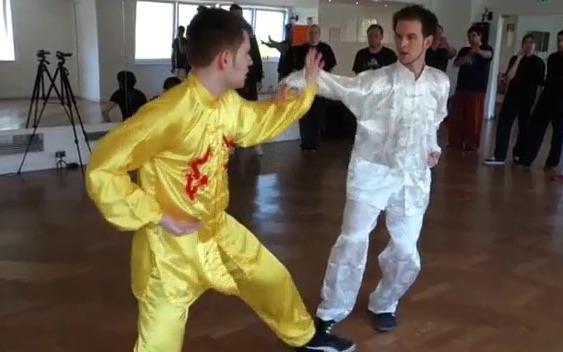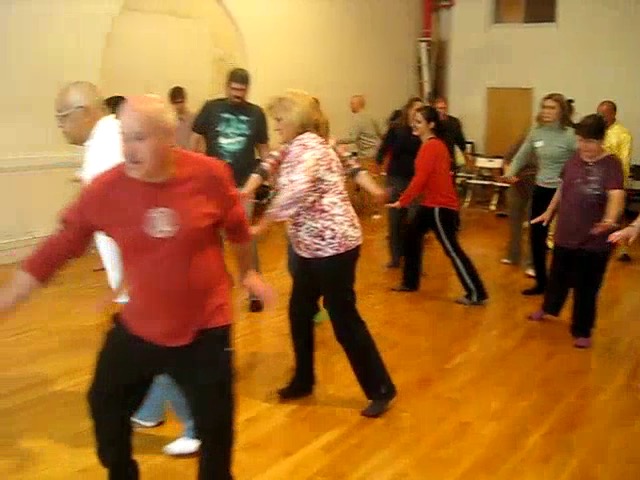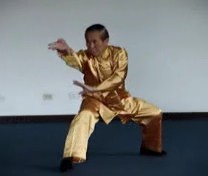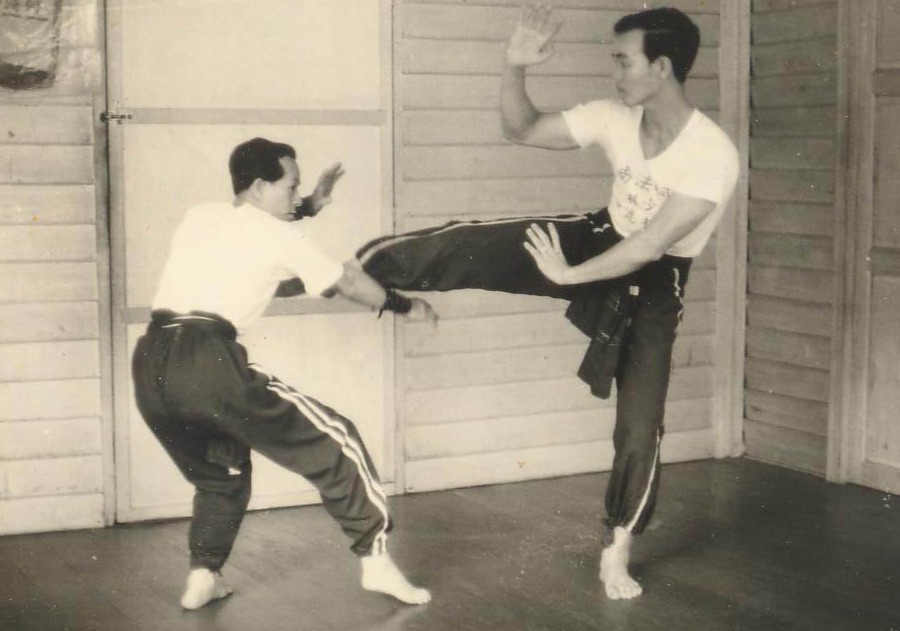SELECTION OF QUESTIONS AND ANSWERS
JULY 2017 PART 1

Dimitri and Sifu Leo in Five-Animal combat application
Question 1
Sigung, is there any relationship between the Shaolin five animals and the five elemental processes?
— Dimitry, Austria
Answer
There is no relationship between the Shaolin five animals and the five elemental processes.
The Shaolin five animals are the dragon, the snake, the tiger, the leopard and the crane. The five elemental processes are the processes of metal, water, wood, fire and earth.
The five elemental processes, known as "wu-xing" in Chinese, are usually mis-translated as five elements. This is a mistake.
The Chinese do not mean that the world is made up of five elements of metal, water, wood, fire and earth. They mean that there are countless processes in the world, but all these processes can be classified into five groups, represented by the processes of metal, water, wood, fire and earth.
In Shaolin Kungfu, some patterns can be classified into five animal forms, namely the dragon form, the snake form, the tiger form, the leopard form and the crane form. The dragon form trains mind, the snake form trains energy, the tiger form trains internal force, the leopard form trains speed, and the crane form trains elegance.
In the five elemental processes, metal represents processes that are sonorous, wood represents processes that grow, water represents processes that spread, fire represents processes that rise, and earth represent processes that come together.
Depending on its application, any Shaolin animal form can manifest any one or more processes. For example, the dragon form in the pattern, "Dragon Chi Spreads Across Stream", can be represented as the metal process when its energy vibrates out, as wood process when it is used to develop internal force, as a water process when the pattern is used to spread energy over the practitioner's body , as a fire process when it is used to lift an opponent's attack, and as an earth process when energy is consolidated at the dan tian.
Similarly, any one of the five processes can be manifested in any of the animal form. For example, the metal process with its vibrational feature can be manifested in a dragon form like "Fierce Dragon Across Stream", in a snake form like "Poisonous Snake Strikes Vital Point", in a tiger form like "White Tiger Presents Claw", in a leopard form like "Golden Leopard Watches Fire", and in a crane form like "Crane Drinks Besides Stream".
Question 2
Is there also any relationship between the Shaolin Five-Animal Set and Hua Tuo's Five-Animal Play?
Answer
There is also no relationship between the Shaolin Five-Animal Set and Hua Tuo's Five-Animal Play. The Five-Animal Play was many centuries older than the Five-Animal Set.
The five animals in the Five-Animal Play are the bird, the deer, the monkey, the tiger, and the bear. The five animals in the Five-Animal Set are the dragon, the snake, the tiger, the leopard and the crane.
Although a crane is also a bird, but the bird represented in the Hua Tuo's Five-Animal Play is small, whereas the crane in the Shaolin Five-Animal Set is big. So, the only animal common in these two sets of five animals is the tiger. But the tiger in the Five-Animal Play is different from the tiger in the Five-Animal Set, as will be explained later.
The five animals in the Five-Animal Play represent typical movements due to different types of energy issuing from internal organs. The main aim of practicing the Five-Animal Play is to overcome illness.
The five animals in the Five-Animal Set represent different ways to develop certain skills. The main aim of practicing the Five-Animal Set is to enhance combat.
Both the Five-Animal Play and the Five-Animal Set give good health, vitality and longevity. But the benefits of the Five-Animal Play, for want of better terms, are "scholarly", whereas those of the Five-Animal Set are "warrior-like". Practicing the Five-Animal Play gives practitioners good health, vitality and longevity in a gentle manner. Practicing the Five-Animal Set gives practitioners good health, vitality and longevity in a vigorous manner.
In the Five-Animal Play, the movements represented by the bird result from the energy of the heart, and the movements are characterized by joy; the deer from the liver, and characterized by anger; the monkey from the spleen, and characterized by anxiety; the tiger from the lungs, and characterized by sorrow; the bear from the kidneys, and characterized by fear.
In the Five-Animal Set, the dragon form trains mind, and is characterized by majesty; the snake form trains energy, and is characterized by flow; the tiger form trains internal force, and is characterized by courage; the leopard form trains speed, and is characterized by strength; the crane form trains elegance, and is characterized by silence.

The Bear Play in five-Animal Play
Question 3
You have often told us that the basics are very important. Five-Animal Set is an advanced set as many patterns are sophisticated and many skills are specialized. If I want to specialize in the Five-Animal Set, how much time must I still spend to train the basic skills?
Answer
Yes, basic skills are very important. Our progress, now and in future, depends on our basic skills.
Skills that are regarded as basic in our school may not be the same as those of other schools. Our basic skills are entering into a chi kung state of mind, or entering Zen or entering Tao, energy flow, stances, footwork, developing internal force, exploding internal force, elegant and smooth movement, and not being tired or panting for breath.
Many schools consider entering Zen or entering Tao as advanced skills, but we consider them basic because all our progress depends on this skill. Developing force and exploding force may not be taught in some schools, though they mention these terms, but we consider these skills basic because all our kungfu is based on internal force, and we need to explode force in combat, which is a primary reason for learning kungfu.
If you want to specialize in the Five-Animal Set or any advanced set, there is no need to spend extra time to practice the basic skills! Many students may be surprised at this statement, but they won't be so surprised when they know the reason.
The reason is that all the basic skills are found in the Five-Animal Set or any advanced set. When you practice the Five-Animal Set or any advanced set, you are already practicing the basic skills. Indeed, you start your specialization because you are already good at the basic skills.
If a student's basic skills are not good, he will be unable to perform the Five-Animal Set well. He can still use the Five-Animal Set to practice his basic skills, but it will be more cost-effective to use a simpler set, like Four-Gate.
If he finds that his basic skills are still not good when he practices Four-Gate, he should "go back one step" to practice the basic skills individually. He may, for example, perfect his stances and footwork, and learn exploding force using "Black Tiger Steals Heart".
Let us now see how the basic skills are practiced in the Five-Animal Set. Before a student starts the set, he enters Zen. In order to perform "Single Dragon Emerges from Sea" well, he must have a good Horse-Riding Stance. He employs "Single Dragon Emerges from Sea" to develop and explode internal force.
When he moves to "Swimming Dragon Plays with Water" and other patterns, he practices his footwork. He also uses chi flow in his movements. But when he performs patterns like "Green Dragon Shoots Pearl" and "Poisonous Snake Shoots Venom", he focuses on his energy flow.
All his movements must be smooth and flowing. When he completes the set, he should not be tired or panting for breath.
All these basic skills are practiced in the Five-Animal Set as well as in any kungfu set. That is why they are called basic skills.
Question 4
How do we enter into a chi kung state of mind?
— Angelo, Italy
Answer
You can enter into a chi kung state of mind by doing just two things, namely be relaxed and free your mind of all thoughts.
As in many things in our school, to be relaxed and to free the mind of all thoughts is easier done than said. All students who attend my regional courses or intensive courses, can be relaxed and be free of all thoughts in the first half hour of a course.
To many other people, to be relaxed and to free the mind of irrelevant thoughts are very difficult. More than 80% of chi kung practitioners all over the world fail to perform these two skills.
Although the chi kung techniques they practice are genuine, they fail to enter into a chi kung state of mind. Because they fail to enter into a chi kung state of mind, they cannot generate an energy flow.
It is the energy flow, not the techniques, that give the benefits of chi kung, like overcoming diseases, and having good health, vitality and longevity. Hence, they do not have the benefits of chi kung although they may have practiced chi kung techniques for many years.

Swimming Dragon Plays with Water
Question 5
At home I often feel tired. When I came here for the chi kung courses, I felt very energized. But now I also feel tired.
— Elizabeth, USA
Answer
You felt tired at home because you did not have enough energy.
When you came here, you generated a lot of energy from the chi kung courses. Hence, you felt very energetized.
But soon there was more energy than your physical body can bear. So you felt tired.
Your feeling tired at home and your feeling tired here are different. At home you did not have enough energy, so you felt tired. If your physical body is represented by yin, and your energy level represented by yang, your yang was lower than your yin, resulting in yin-yang disharmony. Hence you felt tired.
Now you have too much energy. Your yang is higher than yin, which also results in yin-yang disharmony. Hence, you also feel tired.
In the first case, your yin-yang disharmony was due to insufficient yang. So, to overcome the disharmony, you increase yang. A good way to increase yang is to practice chi kug.
In the second case, your yin-yang disharmony is due to excessive yang. A good way to restore yin-yang harmony is to reduce yang. You can do so by expending your energy in a wholesome way, like performing kungfu sets and combat sequences if you know kungfu, and playing games or going to picnics and hiking.
Question 6
I would like to know if one needs physical exercise to be happy and joyful, or is practicing chi kung enough to overcome my problem of depression and anxiety.
— Jussi, Russia
Answer
Practicing our chi kung alone, without doing other exercises and without taking vitamin pills, is sufficient not only to overcome your problem of depression and anxiety, but also to give you good health, vitality and longevity.
Practice your chi kung two sessions a day, once in the morning and the other time in the evening or at night. Each session takes about only 10 minutes.

My sifu, Sifu Ho Fatt Nam sparring with my siheng, or elder kungfu brother
Question 7
Sifu, recently you paid much attention to over-training. From your description we can know that much internal force was developed in Sigung Ho Fatt Nam's school. Did you or your classmates over-train?
— Sifu Leonard Lackinger , Aistria
Answer
We developed a lot of internal force in the school of my sifu, Sifu Ho Fatt Nam. But we did not over-train. This was because we took a long time in our training. My schoolmates and I also did not over-train in the schools of my other three sifus, Uncle Righteousness, Sifu Chee Kim Thong and Sifu Choy Hoong Choy.
In the whole history of kungfu, over-training was not a major problem. It was because masters who had a lot of internal force took a long time to develop their force, often 20 or more years.
Over-training is a unique feature in our school. It is because, paradoxically, we have become so cost-effective. It is difficult for many people to believe but it is true that what our students can attain now in a few days of my intensive courses or even regional courses, it took me many years to achieve. At that time I was already known to be a kungfu genius!
Because our students can attain so much internal force within a short time, the risk of over-training is very high.
Question 8
What is the difference between over-training and deviation? What are the signs showing over-training, and how do we rectify it?
Answer
It is kind for Leo to ask these questions for the benefit of the class. Leo knows the answers very well. He posted a detailed description of over-training in our Shaolin Wahnam Discussion Forum.
There is a crucial difference between over-training and deviation. In over-training a practitioner practices correctly, but the result is too much for his body to handle. In deviation, he practices wrongly. The mistake is usually not on a wrong technique, but because he tenses his muscles or worry excessively.
The remedy for over-training is to reduce the result. This can be accomplished by reducing the time or the intensity of training. In our school, because the training time is relatively short and our students enjoy the training, reducing the intensity is more effective. This can be attained by not entering too deeply into a chi kung state of mind.
The remedy for deviation is to correct the method. If the technique is wrong, then a practitioner changes to a right technique. But usually the fault lies not in a wrong technique, but in tensing his muscles or worrying excessively irrespective of the technique. In other words, even when a right technique is used, if the practitioner is tensed or stressful, deviation occurs.
There are four main signs of over-training
- A practitioner becomes tired
- He feels pain
- His illness becomes worse
- If he was healthy, be becomes sick due to over-training
- Reduce the time or intensity of the training
- Stop training, and resume training only after his over-training has been rectified
- Use his excess energy for wholesome activities, like outings, playing games, performing kungfu sets or sequences
These actions are called negative because they cause harm. But the harm can be erased when they have a chi flow at the end of their exercise.
Participants may not take time at the beginning of their training session to enter a chi kung state of mind. But they will still be performing their techniques in a chi kung state of mind, though they did not take time to enter it at the start, because they have been initiated into a chi kung state of mind, otherwise they will just be performing gentle physical exercise. While they are performing chi kung, make sure they are not too deep in their chi kung state of mind.
LINKS
Selected Reading
- We Cerebrate Life
- Five-Animal Play and our Chi Flow
- Shaolin Five-Animal Set
- Courage and Confidence in Teaching and Healing
- Overcoming So Many Issues
